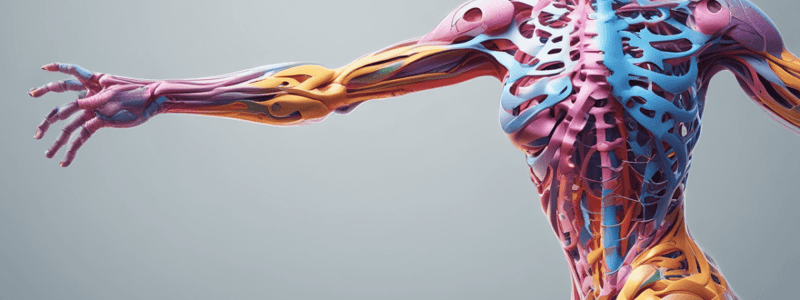Podcast
Questions and Answers
Kinematic description of human movement can provide understanding of how and why the motion is occurring.
Kinematic description of human movement can provide understanding of how and why the motion is occurring.
False (B)
Forces can only produce movement, they cannot arrest or modify it.
Forces can only produce movement, they cannot arrest or modify it.
False (B)
External forces arise from outside the body, while internal forces arise from inside the body.
External forces arise from outside the body, while internal forces arise from inside the body.
True (A)
Gravity is an example of a periodic external force.
Gravity is an example of a periodic external force.
The magnitude of a force is described by its length, the action line and direction are described by its shaft and arrowhead.
The magnitude of a force is described by its length, the action line and direction are described by its shaft and arrowhead.
Forces are scalar quantities, not vector quantities.
Forces are scalar quantities, not vector quantities.
Internal forces cause translation of a body segment.
Internal forces cause translation of a body segment.
External forces applied at a distance from the axis of rotation cause rotation of a body segment.
External forces applied at a distance from the axis of rotation cause rotation of a body segment.
The moment arm is the shortest distance between the force and the axis of rotation.
The moment arm is the shortest distance between the force and the axis of rotation.
Torque is the product of the force and the moment arm.
Torque is the product of the force and the moment arm.
Internal torque is equal to external torque.
Internal torque is equal to external torque.
The internal moment arm is the distance between the joint's axis of rotation and the effective site of external force application.
The internal moment arm is the distance between the joint's axis of rotation and the effective site of external force application.
The center of gravity (COG) of the human body lies approximately anterior to the second sacral vertebra (S2).
The center of gravity (COG) of the human body lies approximately anterior to the second sacral vertebra (S2).
The action line of gravity (LoG) is always oriented horizontally toward the center of the earth.
The action line of gravity (LoG) is always oriented horizontally toward the center of the earth.
The larger the base of support of an object, the greater the stability of that object.
The larger the base of support of an object, the greater the stability of that object.
The location of the center of gravity (COG) is dependent only on the arrangement of segments in space.
The location of the center of gravity (COG) is dependent only on the arrangement of segments in space.
When the line of gravity (LoG) falls outside the base of support (BOS), the body will tend to fall.
When the line of gravity (LoG) falls outside the base of support (BOS), the body will tend to fall.
Flashcards are hidden until you start studying




